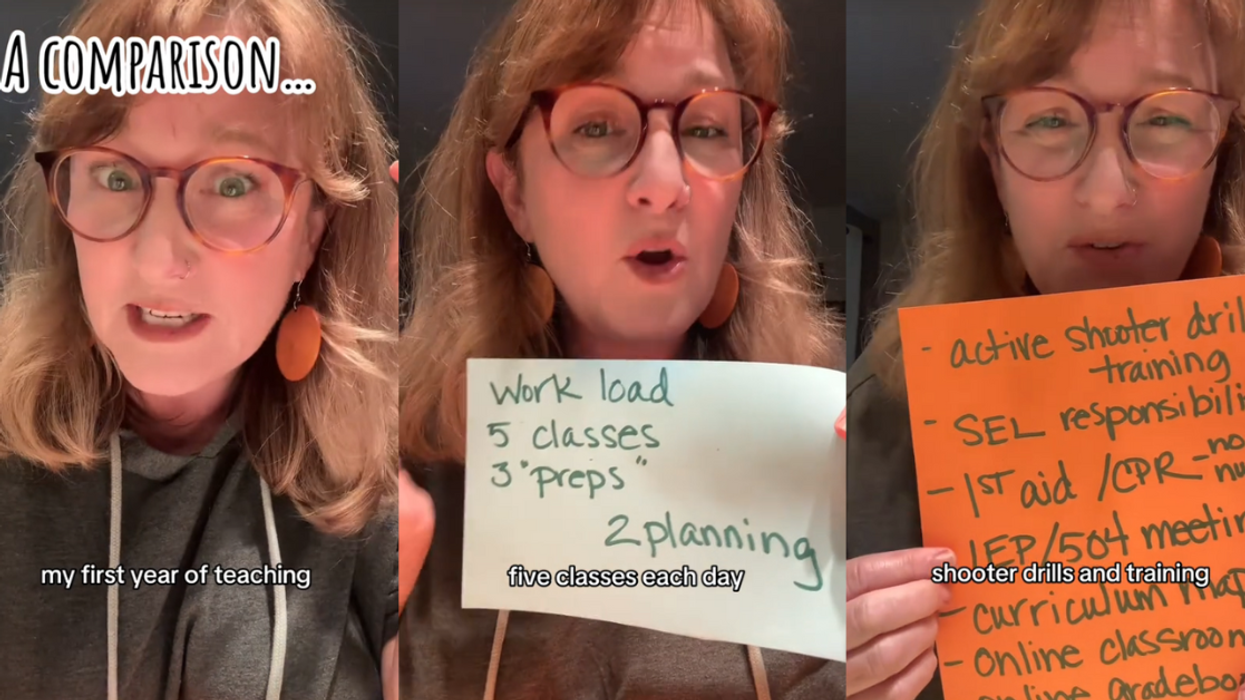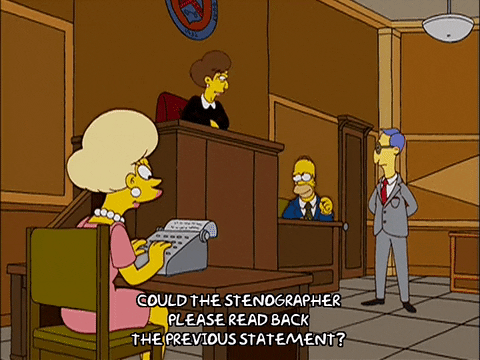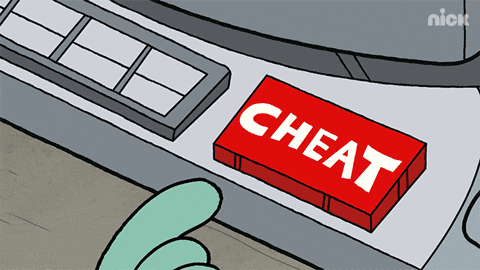It's no secret that the educational system in the United States needs some work, and with teachers' turnover rate being higher than ever before, it's hard to imagine how that's going to happen with fewer teachers entering—and staying in—the classroom.
Many teachers have argued that the demands put on teachers are simply too high and unrealistic for even the best of teachers to be truly successful, but their demands are frequently ignored.
TikToker @gibsonishere has been teaching in the public school system since 1998, and to say that the education system and its demands on teachers have changed a lot in the past almost 30 years would be a severe understatement.
In an eye-opening video, Gibson made a list of commonly-discussed subjects about teacher responsibilities, and she compared what those tasks looked like on her first day of teaching in 1998 with how they look now in the 2024-2025 academic year.
The video started off fairly tame with the general teaching schedule.
"Year One, my work hours were 8:00 AM to 3:00 PM. We had class time from 8:15 AM to 3:00 PM."
"Now, my work hours are 7:30 AM to 3:30 PM. We have class starting at 8:05 AM and going until 3:20 PM."
While teachers in 1998 were able to arrive a few minutes before their students to open up their classrooms, teachers are now required to arrive significantly earlier than their students, and they have to stay after their students leave, not including any other additional duties they might have, which is addressed later in the video.
The video then gets a little more complicated as Gibson describes her then-and-now teacher workloads.
In 1998, she had three "preps," meaning three different kinds of class to prepare lessons for, like English, Creative Writing, and Reading. Since she had five classes, the other two classes would be repeats of the preps, though the schedule might vary somewhat, depending on the needs of her students. There are also two planning periods, so essentially, seven different events happening in her classroom each day.
In 2024, the workday has gotten much more intense:
"I now have six classes, one advisory class, four to five different 'preps' to prepare for, and one planning period. But I only get the planning period maybe four times per week."
Then the video got even stickier with the incorporation of standardized tests.
"Do you want to know how many standardized tests I had to give in 1998? None."
"Now, even though I am not a junior teacher, which is the year we test kids in the state for standardized testing, our school gives one three times per year. So how many times do I have to give it? Three times per year."
During standardized testing weeks, teacher schedules are interrupted to the point that lessons are often completely haulted until the testing week is over. During the class time when the students would otherwise be learning from their curriculum, they instead prepare for and complete their tests and then are asked to perform quiet activities while their peers continue to work.
In the week following standardized testing, teachers often have to use even more class time to review what they previously taught, because their students understandably forgot the content during the testing week.
As for inclusive classrooms, Gibson is all for them, but she wishes that more time was allotted to adequately serve all of her students.
"We used to have our IEP (Individualized Education Program) kids in a 'sheltered class,' which I never liked. I like the push-in model, but keep this in mind for what I'm about to say."
"About 95 percent of them were not in our classes, which means no IEPs, no accommodations, and I like the push-model, but now we're almost completely push-in mode, all of these kids are in with us, and we are given no extra time to deal with their IEPs, to work on accommodations for them, or to go to all the meetings we need to go to for them..."
Keep in mind, Gibson said that she only gets one planning period four times per week. A planning period used to be a time for a teacher to prepare their teaching lessons, review them in case a class had fallen behind in their schedule, and to grade assignments. Now, a planning period also has to accommodate the many different needs of the student population, plus all of the other requirements of a planning period, in less time.
Gibson then went on throughout the rest of the video to describe the many other requirements and expectations teachers have to meet now that they didn't have to meet—or had to do much less—in 1998, like additional duties, meetings, trainings, and other programs with their students and the parents, and all of the online accommodations.
Gibson reassured:
"If you've been doing this this long, too, or if you're just starting, it really is more than it used to be. Thank you for still doing the good work."
You can watch the video here:
@gibsonishere #Inverted A comparison… we are tired for good reason! #edutok #teachersoftiktok #education
Fellow teachers chimed in with their similar experiences, while other TikTokers looked on in shock.










Though good teachers are as important as ever, if not even more so, it's important to send them the message that they are valued and supported, but piling responsibilities onto them in this way does not seem to be the way to send that message.














 Hide Blanket GIF by Instanietje
Hide Blanket GIF by Instanietje  Foam Reaction GIF
Foam Reaction GIF  Mental Health Therapy GIF by All Better
Mental Health Therapy GIF by All Better 

 Friday Driving GIF by FIA World Rally Championship
Friday Driving GIF by FIA World Rally Championship  episode 11 bad food GIF
episode 11 bad food GIF  talking homer simpson GIF
talking homer simpson GIF 
 Cartoons Button GIF by Nickelodeon
Cartoons Button GIF by Nickelodeon 
 @DanTML_/YouTube
@DanTML_/YouTube @voeqx7894/YouTube
@voeqx7894/YouTube @hendrxx9593/YouTube
@hendrxx9593/YouTube @anakinskywalker8877/YouTube
@anakinskywalker8877/YouTube @getshiddonn/YouTube
@getshiddonn/YouTube @sachmanyo/YouTube
@sachmanyo/YouTube